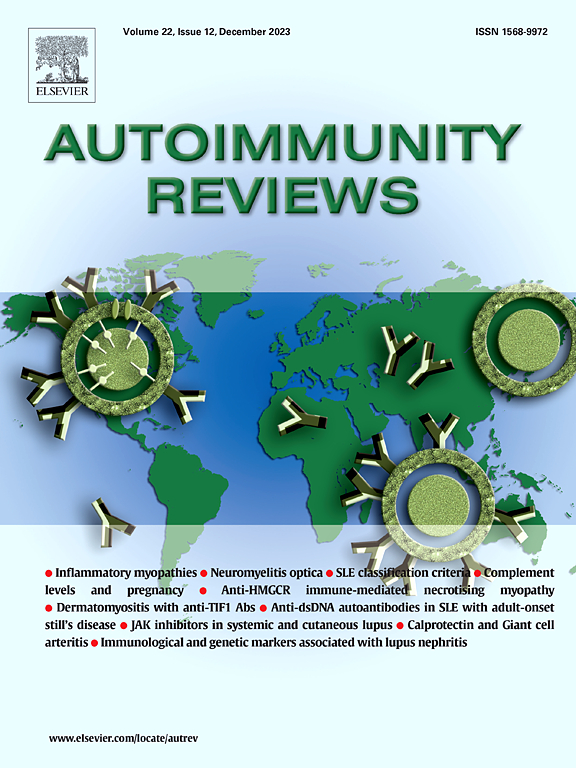The roles of transient receptor potential vanilloid in autoimmune diseases
IF 8.3
1区 医学
Q1 IMMUNOLOGY
引用次数: 0
Abstract
The transient receptor potential vanilloid (TRPV) is a family of tetrameric cation channels, expressed in various tissues and cell types. It includes thermosensitive isoforms (TRPV1–4) and calcium-permeable members (TRPV5–6). In the context of autoimmune diseases, TRPV channels have been firmly established as pivotal regulators that bridge changes in the cellular environment to the immune system.
Originally identified for their roles in thermosensation and nociception, these polymodal sensors have now emerged as crucial determinants of immune cell function. They are capable of converting chemical signals, temperature fluctuations, and mechanical forces into calcium-mediated signal transduction pathways. Mounting evidence indicates that dysregulated TRPV channel activity leads to pathological calcium influx, triggering a signaling cascade that reprograms the functions of key immune cells and modulates pain and itch signaling through neuroimmune crosstalk. These cascades amplify inflammatory responses, exacerbate autoimmune pathology, promote inflammatory cytokine release, and modulate pain/itch signaling via neuroimmune crosstalk.
Specifically, these mechanisms are instrumental in the progression including autoimmune disorders, such as rheumatoid arthritis (RA), inflammatory bowel disease (IBD), systemic lupus erythematosus (SLE), systemic sclerosis (SSc), multiple sclerosis (MS), psoriasis, and atopic dermatitis (AD). Novel therapeutic strategies are emerging, aiming to modulate TRPV activity in autoimmune conditions. Approaches include suppressing hyperactive channels and leveraging their immunoregulatory potential. Promising preclinical results have highlighted that TRPV channels exhibit dual translational potential in mechanistic research of autoimmune diseases, integrating precise targeting with dynamic monitoring capabilities. However, translating these findings into clinical applications faces significant challenges, including differential effects on neuronal and immune signaling, as well as systemic side effects caused by disruptions to physiological homeostasis.
This narrative review discuss how TRPV channel signaling has enhanced our understanding of autoimmune disease initiation. By dissecting how TRPV-mediated immune dysregulation drives pathological immune responses, we seek to offer novel mechanistic insights to inform the development of more effective and comprehensive treatment strategies for autoimmune diseases.
瞬时受体电位香草蛋白在自身免疫性疾病中的作用。
瞬时受体电位香草蛋白(TRPV)是一个四聚体阳离子通道家族,在各种组织和细胞类型中表达。它包括热敏异构体(TRPV1-4)和钙渗透性成员(TRPV5-6)。在自身免疫性疾病的背景下,TRPV通道已被牢固地确立为连接细胞环境变化和免疫系统的关键调节因子。这些多模传感器最初被认为在热感觉和伤害感觉中起作用,现在已成为免疫细胞功能的关键决定因素。它们能够将化学信号、温度波动和机械力转化为钙介导的信号转导途径。越来越多的证据表明,TRPV通道活性失调导致病理性钙内流,触发信号级联,重新编程关键免疫细胞的功能,并通过神经免疫串扰调节疼痛和瘙痒信号。这些级联反应放大炎症反应,加剧自身免疫病理,促进炎症细胞因子释放,并通过神经免疫串扰调节疼痛/瘙痒信号。具体来说,这些机制有助于自身免疫性疾病的进展,如类风湿性关节炎(RA)、炎症性肠病(IBD)、系统性红斑狼疮(SLE)、系统性硬化症(SSc)、多发性硬化症(MS)、牛皮癣和特应性皮炎(AD)。新的治疗策略正在出现,旨在调节自身免疫性疾病中的TRPV活性。方法包括抑制过度活跃的通道和利用其免疫调节潜力。有希望的临床前结果表明,TRPV通道在自身免疫性疾病的机制研究中具有双重翻译潜力,整合了精确靶向和动态监测能力。然而,将这些发现转化为临床应用面临着重大挑战,包括对神经元和免疫信号的不同影响,以及生理稳态破坏引起的全身副作用。这篇综述讨论了TRPV通道信号如何增强了我们对自身免疫性疾病起始的理解。通过剖析trpv介导的免疫失调如何驱动病理性免疫反应,我们寻求提供新的机制见解,为自身免疫性疾病更有效和全面的治疗策略的发展提供信息。
本文章由计算机程序翻译,如有差异,请以英文原文为准。
求助全文
约1分钟内获得全文
求助全文
来源期刊

Autoimmunity reviews
医学-免疫学
CiteScore
24.70
自引率
4.40%
发文量
164
审稿时长
21 days
期刊介绍:
Autoimmunity Reviews is a publication that features up-to-date, structured reviews on various topics in the field of autoimmunity. These reviews are written by renowned experts and include demonstrative illustrations and tables. Each article will have a clear "take-home" message for readers.
The selection of articles is primarily done by the Editors-in-Chief, based on recommendations from the international Editorial Board. The topics covered in the articles span all areas of autoimmunology, aiming to bridge the gap between basic and clinical sciences.
In terms of content, the contributions in basic sciences delve into the pathophysiology and mechanisms of autoimmune disorders, as well as genomics and proteomics. On the other hand, clinical contributions focus on diseases related to autoimmunity, novel therapies, and clinical associations.
Autoimmunity Reviews is internationally recognized, and its articles are indexed and abstracted in prestigious databases such as PubMed/Medline, Science Citation Index Expanded, Biosciences Information Services, and Chemical Abstracts.
 求助内容:
求助内容: 应助结果提醒方式:
应助结果提醒方式:


